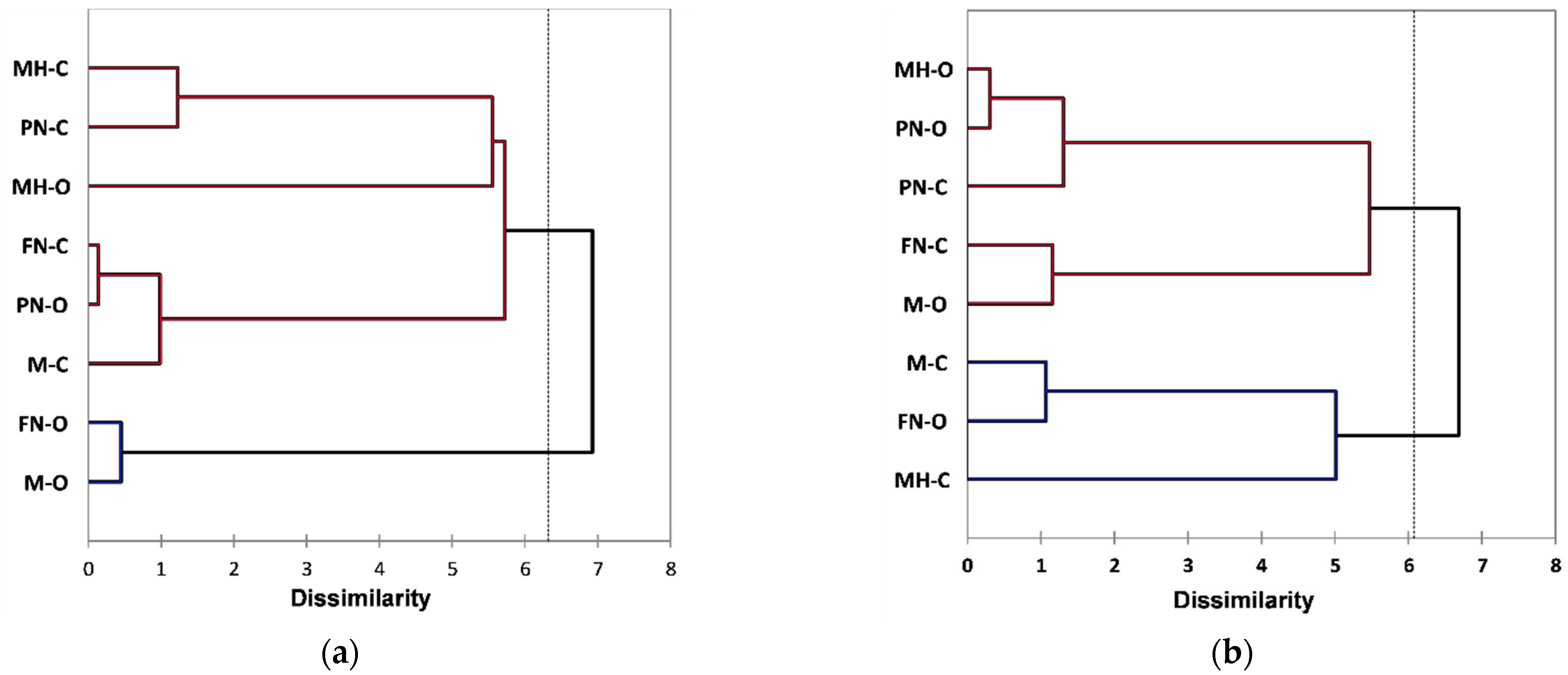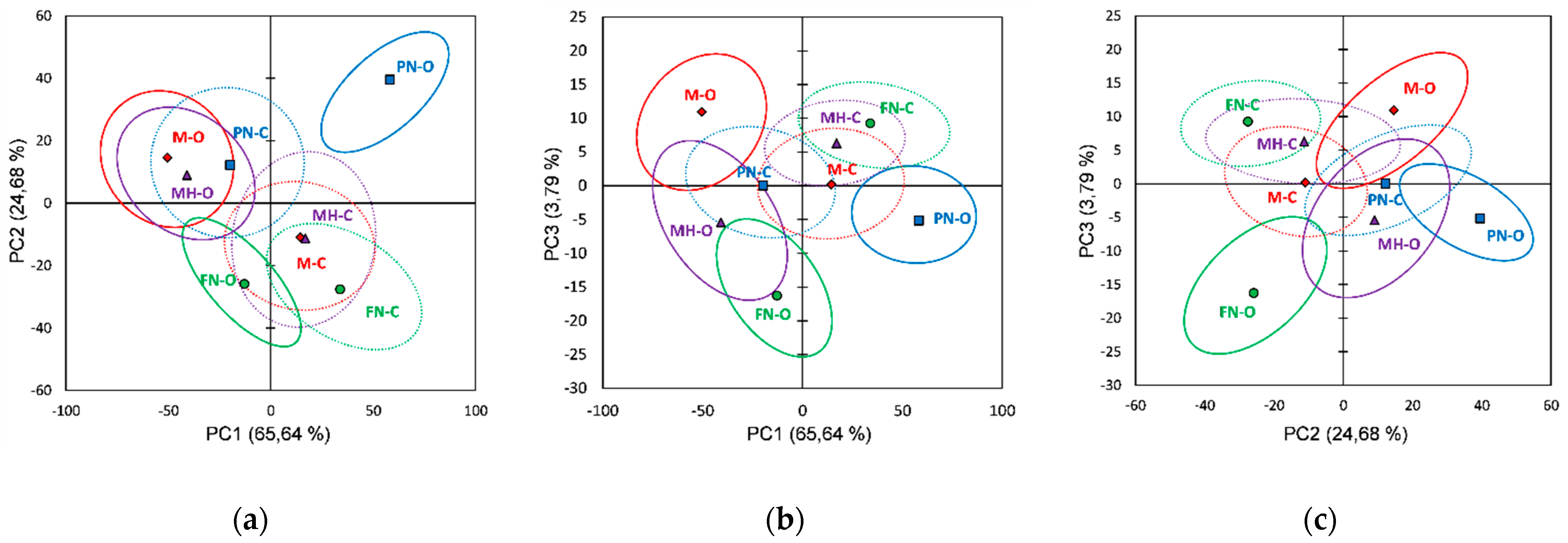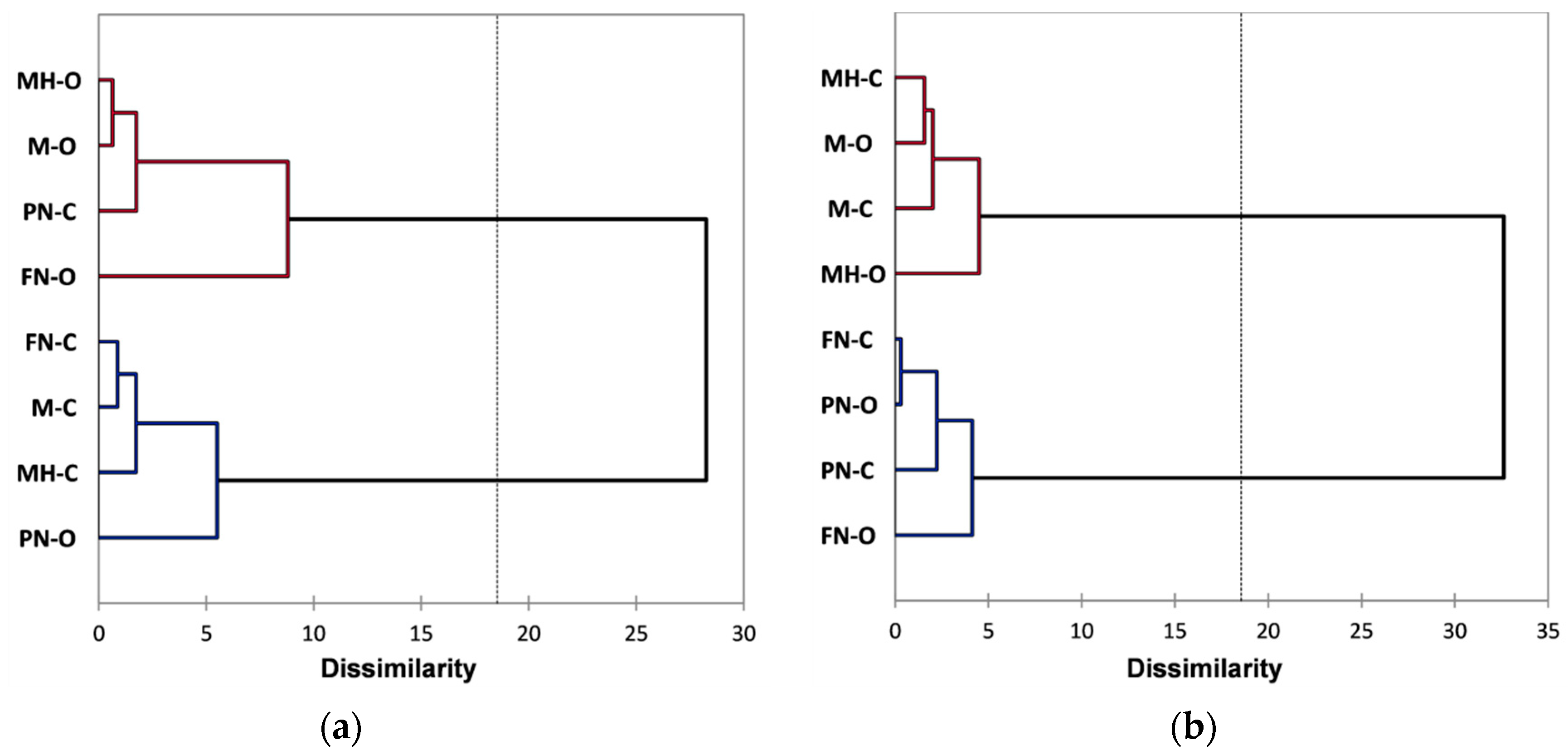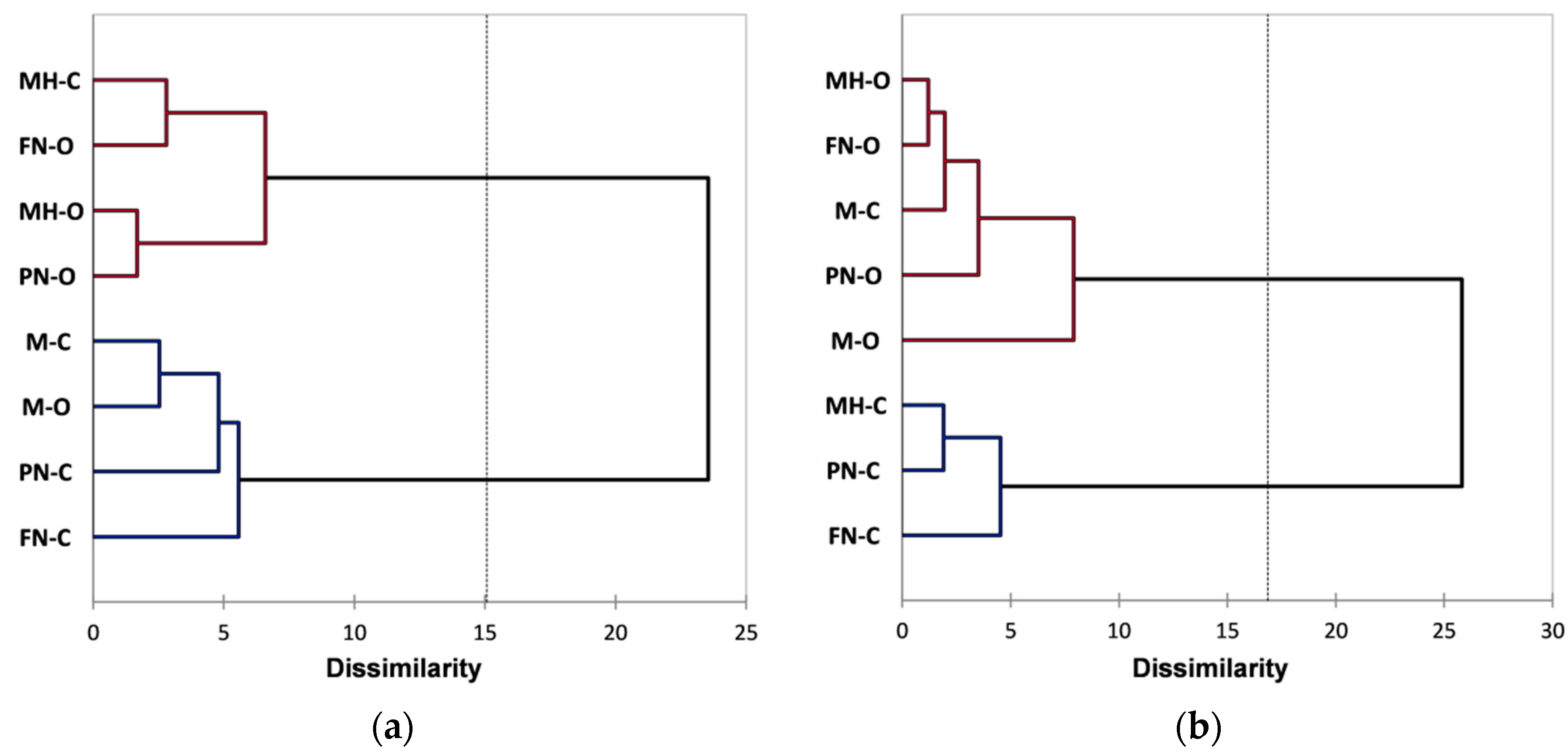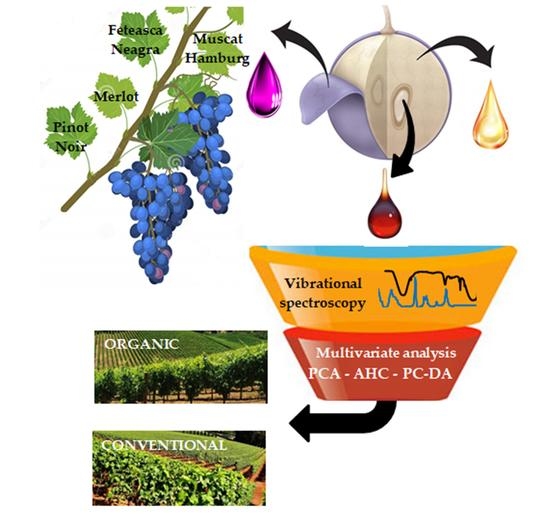3.1. Spectral Properties of Vitis vinifera L. Red Grapes Hydroalcoholic Extracts
The ATR-FTIR spectra of hydroalcoholic extracts corresponding to different berry parts are presented in
Figures S1, S3 and S5, for skin, seeds and pulp, respectively; the corresponding Raman spectra for the extracts mentioned before are presented in
Figures S2, S4 and S6 for the same berry parts. Previous studies reported that quality control and discrimination of natural extracts could be accomplished by using mid-infrared spectroscopy [
63,
64,
65]. Generally, both FTIR and Raman spectroscopy techniques allow obtaining spectra which present some characteristic bands of individual components. These bands provide information about the chemical composition, including both primary and secondary metabolites, of the investigated samples [
66]. In the current research, eight different
Vitis vinifera L. extracts, corresponding to four varieties and two culture systems (organic and conventional), were included in each dataset. For each individual berry part, all of them showed similar FTIR spectral characteristics, with prominent spectral bands being observed at 3293, 3272, 2979, 1641, 1085, 1044 and 877 cm
−1; in the Raman spectra for the same berry parts prominent spectral bands/peaks were observed at 1449, 1274, 1083, 1044, 877, 490, 461 and 432 cm
−1.
Spectral bands in the range 3500–3100 cm
−1 can be attributed to the cumulative stretching vibrations of the -OH groups, characteristic aspect of the polyphenolic extracts [
63,
67,
68,
69] and to the extraction solvent. Usually in this spectral range polyphenolic extracts have vibration bands similar to acids; however, the amount of vibrational contributions of the -OH groups are actually displayed. The spectral band located at 2979 cm
−1 could be attributed to C-H stretching vibrations and to the solvent (ethanol), being due to the stretching vibrations of the O-H groups [
63,
70]. The spectral band of medium intensity located at 1641 cm
−1 can be associated with the aromatic C=C stretching vibrations present in the condensed tannins [
63], as well as C=O stretching vibrations and the presence of unsaturated bonds in flavonoid structures [
69,
71,
72]; the presence of this peak suggests the presence of both flavones and flavanones [
72]. The low intensity bands from 1453 and 1385 cm
−1 can be related with C-H bending vibrations of the CH
2 and CH
3 groups [
71], C=C-C stretching vibrations due to the aromatic ring [
73], bending vibrations associated with aromatic cycles (flavonoids) [
74], and O-H in plane deformation vibrations from polyphenolic compounds [
73]. In the spectral range 1160–900 cm
−1 (bands from 1085 and 1044 cm
−1) spectral peaks can be associated with C-O stretching vibrations of glycosidic moieties and to a lesser extent with aromatic C-O stretching vibrations [
75]. In the spectral range 1400–1150 cm
−1 spectral bands of variable intensity can be assigned to C-O stretching vibrations and C-O-H bending vibrations associated with phenols, esters, carboxylic acids, and alcohols [
75,
76]; the spectral peak from 1085 cm
−1 can be related to the aromatic C-H deformation vibrations in the plane [
67,
77,
78], and C-O deformation vibrations (secondary alcohols, aliphatic esters) [
71,
73]. O-H and C-OH stretching vibrations (polysaccharides of cell walls) can be associated with the spectral band at 1044 cm
−1 [
73]. The spectral peak from 877 cm
−1 can be related with out-of-plane aromatic C-H bending vibrations [
63] and C-O and C-C (monosaccharide) stretching vibrations [
71,
74].
The FTIR spectrum of the seed extracts provides spectral information mostly in the spectral ranges 3350–2900 cm
−1 and 1650–850 cm
−1. The broad, intense spectral band centered at ~3300 cm
−1 can be due to the extraction solvent and to the hydroxyl groups in the structure of the phenolic compounds (stretching vibrations of the hydroxyl groups) [
70]. The bands present at 2978 and 2903 cm
−1 can be associated with asymmetric C-H stretching vibrations due to the methyl and methine groups, respectively [
76,
79,
80]. The spectral band at 1643 cm
−1 is related with the aromatic character, the C-H stretching vibrations [
64,
81], and C=O conjugate stretching vibrations [
79]. The fingerprint region 1500–800 cm
−1 displays spectral bands of variable intensity associated with different vibration modes; although it is a spectral range rich in information, it is difficult to analyze due to its complexity. In this spectral domain the spectral bands can be related with alcohols, sugars, organic acids, and phenolic compounds [
81]. In the region 1390–1310 cm
−1, the spectral bands can be associated with the C-O-H angular deformation vibrations in phenols [
79], out-of-plane methylene bending vibrations (polysaccharides, pectins) [
82], methylene and C-O shear vibrations, as well as the stretching vibrations of the pyranic ring (carbohydrates) [
81,
82]. Spectral bands from 1043 and 877 cm
−1 can be related with C-H deformation vibrations associated with the aromatic ring [
79] and aromatic C-H bending vibrations, respectively [
63,
76].
3.2. Multivariate Analysis Applied on Skin Extracts Spectral Data
Table 2 presents the results of the decomposition of the spectral FTIR and Raman data through PCA, respectively, the percentage of variability/variance explained by each principal component (PC), and the accumulated variability (the sum of percentage of variability explained by that PC and the preceding one). With the first three PCs, 91.47% (i.e., FTIR data) and 94.77% (i.e., Raman data) of the total variability of the studied data were included.
Figure 1 shows the score plots of the FTIR data on the first three principal components explaining 91.47% of the total variability. Several validation techniques have been developed for the PCA. One objective of validation is to estimate the proximity between the observations on a PC plan and to know which observations are significantly different from each other. For that purpose, the partial bootstrap method was employed [
83].
For each original observation we generated the 95% confidence ellipses based and centered on the bootstrap points. Two categories of samples can be well distinguished if the overlapping area is smaller on a given PC plan; if the samples of the same category were more concentrated, the curve will be sharper with a small value of standard deviation [
84,
85,
86].
For the FTIR data it was observed (
Figure 1) that the investigated red grape varieties overlapped (bootstrap ellipses) at different extents in all plots, and thus incomplete separations between varieties were noticed. However, it can be distinguished a separation between vineyard types (organic vs. conventional) for the same grape variety, organic skin extracts being well separated in PCs plots: PC1 vs. PC2 (Merlot and Feteasca Neagra), PC1 vs. PC3 (Pinot Noir and Muscat Hamburg) and PC2 vs. PC3 (Merlot, Feteasca Neagra and Muscat Hamburg). The loading values for the first three PCs obtained using the FTIR data are represented in
Figure S7.
The skin extracts’ FTIR datasets processing using PCA reveal that the Merlot vineyards can be differentiated based on PCs loading plots (
Figure S7) due to positive PC2 (M-O) and negative PC1 (M-C) loading plots. The Feteasca Neagra and Pinot Noir, organic and conventional vineyards, can be differentiated due to PC2 (FN-O positive loadings and FN-C negative loadings) and PC1 (PN-O negative loadings and PN-C positive loadings) loading plots, respectively. For the Merlot organic vineyards (M-O), the main spectral differences relative to the conventional ones (M-C) were assigned to the following spectral regions/peaks: 4000–3750, 2640–2460, 2390–2950, 1950–1900, 1465 and 890 cm
−1. The Feteasca Neagra organic vineyard (FN-O) can be differentiated from conventional culture (FN-C) by 4000–3730, 2550–2450 and 1980–1920 cm
−1 spectral regions. The Pinot Noir organic vineyard (PN-O) can be discriminated from the conventional one (PN-C) due to 2990–2500, 2370–2350, 1460–1250, 1190–990 and 890 cm
−1 spectral regions/peaks. The Muscat Hamburg organic vineyard (MH-O) can be differentiated especially due to PC3 (
Figure 1b,c) positive scores; the PC3 loading plot (
Figure S7) revealed the main spectral specific features in 3950–3680, 2470, 2360–2330, 2170, 2035, 1830–1770 and 1496 cm
−1 spectral regions.
Figure 2 shows the score plots of the Raman data, relative to the red grape skin extracts, on the first three principal components explaining 94.77% of the total variability. From the Raman data score plots it was observed that red grape varieties (skin extracts) overlap partially in all plots; for the FTIR data, an incomplete separation between varieties is noticed. Except for the Pinot Noir, a separation (organic vs. conventional) can be observed for the same grape variety in almost all PCs plots; PN-O vs. PN-C can be more clearly differentiated in the PC2 vs. PC3 plot. Based on the first two PCs scores and signs and accounting also for the contribution and squared cosines of the observations, it can be identified three (FTIR data) and four clusters/groups (Raman data), respectively. PCs score plots resulted from Raman data also show a better separation between organic and conventional vineyards, three of the organic skin extracts (M-O, PN-O and MH-O) being assigned in the same cluster.
Figure S8 shows the loadings plots for the first three principal components (PCs) using Raman data (red grape skin extracts).
Based on the first three PCs loading plots (
Figure S8), obtained by using PCA on the skin extracts’ Raman datasets, a differentiation between organic and conventional culture for each variety investigated was also revealed. The organic Merlot vineyard (M-O) can be distinguished (positive loading for PC1) by 2000–1200, 1140–970, 900–700, 600 and 250–230 cm
−1 spectral regions. The Feteasca Neagra organic vineyard can be differentiated (PC3 positive loadings over 0.2) by 1350, 1220–1156, 977, 944, 675 and 323–293 cm
−1 spectral regions/peaks. The Pinot Noir organic vineyard (PN-O) can be differentiated due to PC2 negative loadings by 1986, 1654, 1596, 1465, 1225–1090 and 720–620 cm
−1 spectral regions. In the case of the Muscat Hamburg variety, organic culture (MH-O) can be differentiated by 1650–1600, 1230, 1100–1020 and 790–700 cm
−1 spectral regions.
Further analysis was performed using Agglomerative Hierarchical Clustering (AHC) that allows a clear view of the similarities and differences between red grape skin extracts. The AHC derived from the FTIR data has grouped both organic and conventional extracts into two main classes/clusters.
Figure 3a presents the dendrogram showing the division into clusters and the inclusion of extracts in each cluster/subcluster (automatic truncation-entropy, variance decomposition for the optimal classification: within-class 97.2%, between-classes 2.8%). From classifications made using AHC based on Raman spectral data, organic and conventional extracts are similarly included into two main clusters, as can be seen in
Figure 3b (automatic truncation-entropy, variance decomposition for the optimal classification: within-class 77.7%, between-classes 22.3%).
As can be observed for the FTIR data processing using AHC (
Figure 3a), classification reveals two main clusters: the first included FN-O and M-O extracts and the second included the rest of the extracts, a good classification based on vineyard type, relative to all four varieties, cannot be observed. However, at a lower dissimilarity level (2 ÷ 5), subclusters division allows a classification based on vineyard type, excepting PN-O; also, a differentiation can be made for each grape variety between organic and conventional extracts. From all grape varieties, Merlot and Feteasca Neagra show the most notable difference between organic and conventional vineyards (M-O vs. M-C and respectively FN-O vs. FN-C), the corresponding extracts for each variety, organic and conventional, being assigned in the two main clusters. The AHC classification based on the Raman data (
Figure 3b) shows two main clusters, the first of which includes MH-O, PN-O, PN-C, FN-C and M-O extracts, and the second of which includes M-C, FN-O and MH-C extracts; a good classification based on vineyard type, relative to all four varieties, cannot be observed. Compared with the FTIR data, at a lower dissimilarity level (2 ÷ 5), subclusters division does not allow a clear classification based on vineyard type; a differentiation between organic and conventional extracts can be made, for each grape variety, only at a lower level of dissimilarity (1 ÷ 1.3).
In many cases, the interpretation of the complex biochemical information obtained through vibrational spectroscopy requires further data analysis using supervised procedures [
33,
39]. After PCA was applied, the first three PCs scores were retained for further analysis using the so-called PC-DA model by combining both PCA and discriminant analysis (DA) [
42,
87,
88].
The classification and cross-validation by PC-DA was applied onto all extracts. The quadratic discriminant analysis was chosen based on the two Box tests (Chi-squared asymptotic approximation and Fisher’s F asymptotic approximation) and Kullback’s test (the significance level was set at 5%). The PC-DA results corresponding to skin extracts are presented in
Table 3,
Table 4 and
Table S1–S6 for both FTIR and Raman spectral data.
3.3. Multivariate Analysis Applied on Seed Extracts Spectral Data
Table 5 presents the results of the decomposition of the spectral FTIR and Raman data (red grape seed extracts) through PCA, respectively the percentage of variability/variance explained by each principal component and the accumulated variability. With the first three PCs, 94.11% (i.e., FTIR data) and 96.64% (i.e., Raman data) of the total variability of the studied data were included.
Figure 4 shows the score plots of the FTIR data on the first three principal components explaining 94.11% of the total variability. The bootstrap ellipses corresponding to the investigated red grape varieties overlapped at different extents in all plots, and thus, incomplete separations between varieties were noticed. However, a separation can be made between vineyard types for the same grape varieties, organic vs. conventional extracts being well distinguished especially in the PC1 vs. PC3 plot, but also in the PC1 vs. PC2 (Merlot and Pinot Noir) and PC2 vs. PC3 (Feteasca Neagra) plots. The loading plots for the first three PCs obtained using FTIR data are represented in
Figure S9.
PCA applied on the FTIR spectra of seeds extracts has allowed a differentiation between organic and conventional culture systems, the main spectral features being observed in the PC1 loading plot (
Figure S9): M-O, FN-O and MH-O due to negative values and PN-O due to positive values of PC1 loading plot, respectively. The organic Merlot seeds’ extract (M-O) can be differentiated from conventional ones (M-C) due to 3810, 3760, 2980–2400, 1385, 1100–1020 and 880 cm
−1 spectral regions/peaks. The organic Feteasca Neagra seeds’ extract (FN-O) can be differentiated from conventional ones (FN-C) due to 3830, 3750, 2980–2850, 2360, 2160, 2040, 1750–1480, 1385, 1100–1020 and 880 cm
−1 spectral regions/peaks. Pinot Noir organic seeds extract (PN-O) can be discriminated from conventional one (PN-C) due to 4000–2980, 2400–1460, 1250–1120 and 900–870 cm
−1 spectral regions. Muscat Hamburg organic seeds extract (MH-O) can be discriminated from conventional one (MH-C) due to 2980, 2930–2850, 1385, 1100–1020 and 880 cm
−1 spectral peaks/regions.
From the Raman data score plots (
Figure 5), the first three principal components explaining 96.64% of the total variability, it was observed that red grape varieties (seeds extracts) overlap at different extents in all plots; and from the FTIR data an incomplete separation between varieties is noticed. A distinction between vineyard type (organic vs. conventional) for same grape varieties can be made mainly for the Muscat Hamburg (in both PC1 vs. PC2 and PC2 vs. PC3 plots), for other varieties the bootstrap ellipses being overlapped at different extents in all three plots; a better view can be noticed in PC2 vs. PC3 (Merlot and Pinot Noir) and PC1 vs. PC3 (Feteasca Neagra) plots. A better differentiation also can be observed between vineyard types for the FTIR data, organic seed extracts being assigned to different clusters, excepting the ones which include M-O, MH-O and PN-C.
Figure S10 shows the loadings plot for the first three principal components (PCs) using Raman data (red grape seed extracts).
Based on the first three PCs loading plots (
Figure S10), obtained by applying PCA on seeds extracts Raman data, a differentiation between the organic and conventional culture for each variety investigated is also revealed. As a result, M-O and MH-O (PC2 negative loadings), FN-O (PC3 negative loadings), and PN-O (PC2 positive loadings), can be discriminated from corresponding extracts obtained from conventional culture. The main spectral differences identified for the investigated organic varieties are as follows: M-O is differentiated from M-C by 1980, 1470–1430, 1260, 1100–1040, 900–830 and 570–380 cm
−1 spectral regions; FN-O is differentiated from FN-C by 1980, 1800, 1695, 1565, 1195, 970 and 945 cm
−1 spectral peaks. PN-O can be differentiated from PN-C by 1566, 1220, 1188, 1170, 990, 935 and 665 cm
−1 spectral peaks. MH-O can be differentiated from MH-C by 1980, 1470–1430, 1260, 1110–1040, 900–830 and 570–380 cm
−1 spectral regions/peaks.
AHC derived from FTIR data has grouped both organic and conventional extracts into two main classes/clusters.
Figure 6a presents the dendrogram showing the division into clusters and the inclusion of extracts in each cluster/subcluster (automatic truncation-entropy, variance decomposition for the optimal classification: within-class 55.88%, between-classes 44.12%). From classifications made using AHC based on Raman spectral data, organic and conventional extracts are similarly included into two main clusters, as can be seen in
Figure 6b (automatic truncation-entropy, variance decomposition for the optimal classification: within-class 49.13%, between-classes 50.87%).
As can be observed for the FTIR data (
Figure 6a), AHC classification reveals two main clusters: the first includes M-O, FN-O, PN-C and MH-O and the second includes M-C, FN-C, PN-O and MH-C extracts; excepting the PN variety, a classification based on vineyard type can be noticed. Also, a differentiation can be made for each grape variety, between organic and conventional extracts (M-O vs. M-C, FN-O vs. FN-C, PN-O vs. PN-C, MH-O vs. MH-C), corresponding extracts being assigned in the two main different clusters. Classification based on Raman data (
Figure 6b) also shows two main clusters, the first of which includes M-O, M-C, MH-O and MH-C extracts, and the second of which includes FN-O, FN-C, PN-O and PN-C extracts; a good classification based on vineyard type, relative to all four varieties, cannot be observed. Compared with the FTIR data, at a lower dissimilarity level (2 ÷ 4.5), subcluster division allows a clear classification based on vineyard type (M-O vs. M-C, FN-O vs. FN-C, PN-O vs. PN-C, and MH-O vs. MH-C).
The first three principal component scores were retained for further analysis; classification and cross-validation by PC-DA was applied onto all extracts. The two Box tests (Chi-squared asymptotic approximation and Fisher’s F asymptotic approximation) and Kullback’s test, confirmed that the within-class covariance matrix is different (significance level 5%) for both the FTIR and Raman datasets.
Table 6 and
Table S7–S9 list the PC-DA results obtained based on the FTIR datasets, for Raman datasets corresponding results are displayed in
Table 7 and
Table S10–S12, respectively.
3.4. Multivariate Analysis Applied on Pulp Extracts Spectral Data
The results of the decomposition of the spectral FTIR and Raman data (red grape pulp extracts) through PCA, respectively, the percentage of variability/variance explained by each principal component (PC) and the accumulated variability are presented in
Table 8. With the first three PCs, 91.05% (i.e., FTIR data) and 91.13% (i.e., Raman data) of the total variability of the studied data was included.
PCA score plots of the pulp extracts’ FTIR data on the first three principal components (91.05% of the total variability) are presented in
Figure 7. The bootstrap ellipses corresponding to the investigated red grape varieties overlapped at different extents in all plots, and thus incomplete separations between varieties were noticed; only the Muscat Hamburg variety seems to be better differentiated from the rest, as can be seen in all PCs plots. For the other three varieties, a separation between vineyard type can be clearly noticed for the Merlot (
Figure 7a,c), the Feteasca Neagra (
Figure 7b,c), and the Pinot Noir (
Figure 7a,b). The loading plots for the first three PCs obtained using FTIR data are presented in
Figure S11.
PCA loading plots obtained by processing the pulp extracts’ spectral datasets (
Figure S11) can differentiate organic from conventional culture based on negative loading values for PC1 (PN-O), PC2 (M-O, MH-O) and PC3 (FN-O). For the Merlot organic (M-O) the main spectral differences, relative to the conventional one (M-C), were assigned to the following spectral regions/peaks: 3859, 3811, 3747, 3396, 2343, 2171, 2025, 1764–1750 and 1502 cm
−1. The Feteasca Neagra organic extract (FN-O) can be differentiated from the conventional one (FN-C) by 3965, 3923, 3800, 2987, 2460, 2360, 2341, 1558, 1506, 1041, 948 and 881 cm
−1 spectral peaks. The Pinot Noir organic extract (PN-O) can be differentiated from PN-C by the peaks in the 3950–3730, 2980–2535, 1430–1285 and 1130–947 cm
−1. The Muscat Hamburg organic extract (MH-O) can be differentiated due to 3859, 3811, 3747, 3396, 2343, 2025, 1764–1753 and 1502 cm
−1 spectral peaks/regions.
From PCA Raman data score plots (
Figure 8), it was observed that red grape varieties (pulp extracts) overlap at different extents in all plots; for the FTIR data, an incomplete separation between varieties is noticed. Vineyard type differentiation for the same grape variety can be observed clearly for the Muscat Hamburg in all three plots. The Merlot and Feteasca Neagra (organic vs. conventional) can be also differentiated in PC1 vs. PC2, PC1 vs. PC2 and PC2 vs. PC3 plots. It can be noticed that the PCA score plots for both the FTIR and Raman data of pulp extracts display almost the same clustering when compared with corresponding plots of skin and seed extracts. There can be assigned four clusters, two of which have been identical for both FTIR and Raman data: (i) M-O and PN-C (FTIR and Raman); (ii) PN-O and MH-O (FTIR and Raman); (iii) FN-O and MH-C/M-C (FTIR/Raman) and (iv) FN-C and M-C/MH-C (FTIR/Raman).
Figure S12 shows the loading plots for the first three principal components using Raman data (red grape pulp extracts). Based on the first three PCs loading plots (
Figure S12) obtained by applying PCA on the pulp extracts’ Raman data a differentiation between organic and conventional culture for each variety investigated can also be revealed. The organic Merlot (M-O) can be differentiated (positive PC2 loading values) by 1874–1733, 1350–1327, 1124, 1100, 1010, 893 and 680–310 cm
−1 spectral regions/peaks. The Feteasca Neagra organic extract (FN-O) can be differentiated (negative PC3 loading values) from FN-C by 1661, 1574, 1559, 1312, 1227–1172, 969, 702 and 629 cm
−1 spectral features. The Pinot Noir organic extract (PN-O) can be differentiated (negative PC1 loading values) by 537–393, 353, 303 and 242 cm
−1 spectral regions/peaks. The Muscat Hamburg organic extract (MH-O) can be differentiated by 1456, 1281, 1084–1073, 885, 537–393, 353 and 242 cm
−1 spectral peaks due to PC1 negative loading values.
The AHC derived from the FTIR data has grouped both organic and conventional pulp extracts into two main classes/clusters.
Figure 9a presents the dendrogram showing the division into clusters and the inclusion of extracts in each cluster/subcluster (automatic truncation-entropy, variance decomposition for the optimal classification: within-class 63.31%, between-classes 36.69%). From classifications made using AHC based on Raman spectral data, organic and conventional pulp extracts are similarly included into two main clusters, as can be seen in
Figure 9b (automatic truncation-entropy, variance decomposition for the optimal classification: within-class 53.96%, between-classes 46.04%).
AHC performed on the pulp extracts’ FTIR data (
Figure 9a) reveals a classification into two main clusters, the first includes M-O, M-C, FN-C and PN-C extracts and the second includes FN-O, PN-O, MH-O and MH-C extracts; a clear classification cannot be noticed based on vineyard type. A differentiation can be made for each grape variety, between organic and conventional extracts, especially for the Feteasca Neagra and the Pinot Noir, FN-O, PN-O and FN-C, PN-C being assigned in the two main clusters. The Merlot and Muscat Hamburg varieties can be differentiated at a lower level of dissimilarity (2.5 for M-O vs. M-C and respectively 6.6 for MH-O vs. MH-C). Classification based on Raman data (
Figure 9b) also shows two main clusters, the first of which includes M-O, FN-O, PN-O, MH-O and M-C extracts, and the second of which includes FN-C, PN-C and MH-C extracts; it can be observed a classification based on vineyard type, relative to all four varieties, excepting Merlot. A differentiation can be made for each grape variety, between organic and conventional extracts for the Feteasca Neagra, Pinot Noir and Muscat Hamburg varieties, the corresponding extracts being assigned in the two main clusters. The Merlot vineyards, M-O vs. M-C, can be differentiated at a lower level of dissimilarity (i.e., 7.9).
Similarly, as for skin and seed extracts, the first three principal component scores were retained for further analysis; classification and cross-validation by PC-DA was applied onto all extracts. The two Box tests (Chi-squared asymptotic approximation and Fisher’s F asymptotic approximation) and Kullback’s test, confirmed that the within-class covariance matrix is different (significance level 5%) for both the FTIR and Raman datasets.
Table 8 and
Table S13–S15 list the PC-DA results obtained based on the FTIR spectral data. The corresponding results based on Raman spectral data are presented in
Table 9 and
Table S16–S18.


